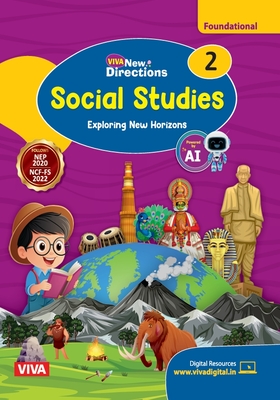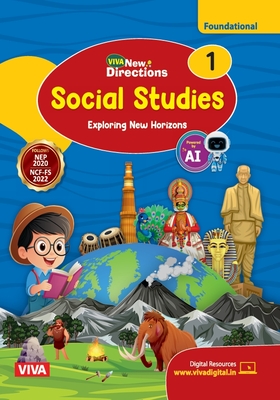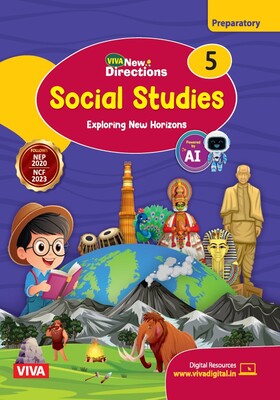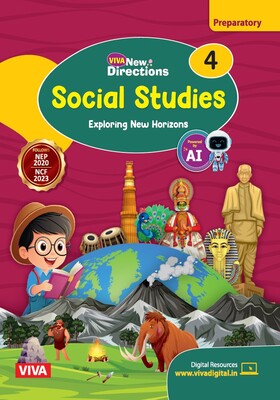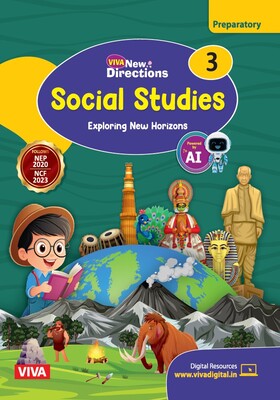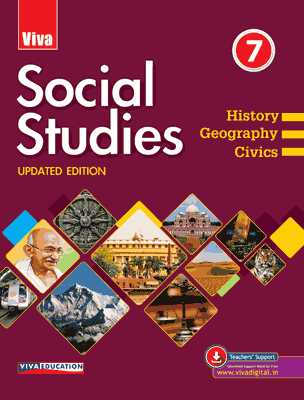
Viva Social Studies - 7 (Updated Edition)
Viva Social Studies - 7 (Updated Edition)
History, Geography, Civics
₹555.00
Go to cartISBN: 9789389401783
Bind: Paperback
Year: 2020
Pages: 260
Size: 8.5 x 11 Inch
Publisher: Viva Education
Exclusive Distributors: Viva Books
Sales Territory: Worldwide
Viva Social Studies is a set of eight books for classes 1 to 8, designed and developed keeping in mind the latest guidelines framed by the CBSE. The series helps to build knowledge about humankind and the physical and social world we live in. It is an activity-oriented series with creatively designed exercises and individual and group projects and activities.
Salient Features of Books 6 to 8
- Lucid language is used for easy comprehension.
- Colourful pictures and well-labelled diagrams help to reinforce the concepts.
- Various tasks are provided within each lesson in the form of Extract, Search and Surf, Picture-based questions and Answer Orally.
- Thinking skills are included as Brainstorm.
- Quick outline of the main topics is given as Learning Outcomes.
- Memory tool featuring salient points of the chapter is presented in Recap.
- Assessment tasks are presented in chapter-end exercises.
- Meanings and definitions of new words are given as Footnotes.
- Meanwhile (in History) helps to trace the contemporary scenario of the other countries in the same age.
- Web charts, tables, case studies, maps and many other features are given for quick reference.
- Each book is accompanied with Teacher's Resource Pack that includes Teacher's Guide and Digital Resources.
Teacher's Guide:
- Lesson Plans
- Answers to In-text Exercises
- Answer Key to Chapter-end Exercises
- Assessment Sheets
- Additional Activities and Projects
Teachers' Support material can be downloaded from www.vivadigital.in
Target Audience:
CBSE Students of Class 7.
Contents:
History
Chapter 1. Studying the Medieval Period • Cartography and other sources of history • Sources for studying medieval Indian history • Major political and economic developments in India • New social and political groups • Major religious developments in India
Chapter 2. Kings and Kingdoms of the Early Medieval Period • Important kingdoms in the Indian subcontinent during 700-1200 • The tripartite struggle and administration of the regional kingdoms • Invasions by Mahmud of Ghazni, Muhammad of Ghor and the Battles of Tarain • The Chola Kingdom • Case Study: The Cholas
Chapter 3. The Delhi Sultanate • Sources of information for the Sultanate period • The Slave or Mamluk dynasty, the Khalji dynasty • The Tughluq dynasty, Timur's invasion, the Sayyid dynasty, the Lodi dynasty • The developments in Sultanate period, the Mongol problem • Case Study: Muhammad bin Tughluq's policies
Chapter 4. The Mughal Empire • The Great Mughals—Babur, Humayun and some of their achievements • Sher Shah Suri and his contributions • Jahangir, Shah Jahan, Aurangzeb and their reigns • Important features of the Mughal administrative system • The Mughal Empire after the Great Mughals • Case Study: Akbar the Great
Chapter 5. Medieval Monuments • Medieval Hindu Architecture • Indo-Islamic Architecture • Sultanate and Mughal architecture • Building materials and labour • Monuments as source of history, regional influences on architecture • Case Study: Architecture under Shah Jahan
Chapter 6. Towns, Traders and Craftsmen • Capital towns or administrative centres • Temple towns and pilgrimage centres • Port towns, craft towns and founded towns • Traders, artisans and craftsmen • Case Studies: Hampi, Surat, Masulipatnam
Chapter 7. Tribal Communities • Tribes in the medieval period • Life of the tribal people • Cultural changes in tribes • Case Studies: Ghonds and Ahoms
Chapter 8. Religious Developments • Bhakti, its spread in India and some famous Bhakti saints • The birth of Sikhism • Islam, Sufism and its features • Other sects and movements • Pilgrimages • Case Study: Kabir
Chapter 9. Flowering of Regional Cultures • Development of languages • Regional texts as sources • Painting, music and dance forms that developed during the medieval period • Case Study: Bengal
Chapter 10. Political Formations in the Eighteenth Century • The Later Mughals • Foreign invaders • Battle of Buxar • The last Mughal emperor • Reasons for the decline of the Mughal Empire • Rise of independent kingdoms • Rajputs, Sikhs, Jats and Marathas • Case Study: Shivaji
Geography
Chapter 1. Our Environment • Natural environment • Domains or realms of Earth • Ecosystem • Human environment
Chapter 2. Inside Our Earth • Structure of the Earth • Rocks and minerals • Rock cycle • Uses of rocks and minerals
Chapter 3. Our Changing Earth • The theories of continental drift and plate tectonics • Mountain building • Volcanoes and earthquakes • Case Study: The Japanese earthquake and Tsunami of 2011
Chapter 4. Major Landforms • Landforms created by rivers • Landforms created by sea waves • Landforms created by moving ice • Landforms created by wind
Chapter 5. Atmosphere • Composition of atmosphere • Importance of atmospheric gases • Structure of atmosphere
Chapter 6. Elements of Weather and Climate • Weather and climate • Temperature • Atmospheric pressure • Wind • Humidity • Condensation, precipitation
Chapter 7. Major Water Bodies • Water cycle • Distribution of water bodies • Oceans • Movements of the ocean
Chapter 8. Natural Vegetation and Wildlife • Forests • Grasslands • Deserts • Tundra regions
Chapter 9. Human Environment • Settlements and their types • Transport and its types • Different forms of communication
Chapter 10. Life in the Tropical and Subtropical Regions • The Amazon basin • The Ganga-Brahmaputra basin
Chapter 11. Life in the Deserts • Sahara, a hot desert • Ladakh, a cold desert
Civics
Chapter 1. Equality in Democracy • Equality in Indian democracy • Decision-making mechanism • Accommodation of differences • Guarantee to individual dignity • Other democracies and their struggle for equality
Chapter 2. The State Government—Its Working and Role • Federal system • The state legislatures • Process of making laws • The state executive • Role of State government
Chapter 3. Role of Government in Healthcare • Defining health • Healthcare in India • Distribution of resources • Financing healthcare services • Public and private healthcare system • Access of resources to communities • Case studies: Kerala and Costa Rica
Chapter 4. Media and Democracy • Definition of media • Different forms of media • Public opinion and media in democracy • Responsibilities and freedom of media • Legal checks and RTI • Censorship
Chapter 5. Advertising • Objective of advertising • Types and techniques of advertising • Advantages and disadvantages of advertising • Media and advertising • Social responsibility
Chapter 6. Gender and Our Country • Women in the household and stereotypes • Women community and social evils • Women in public places • Role of media and education • Equality, Constitution, gender and government initiatives • Understanding inequality
Chapter 7. Economic Aspects of Gender • Division of labour at home • Informal and formal sectors • Invisibilization of women's labour • Call for awareness
Chapter 8. Markets Around Us • Definition of a market • Types of markets • Types of retailers and stores • Choosing a market • Advertisement and importance of markets
Chapter 9. A Wholesale Market • Defining a wholesale market • Efforts by the government and new trends • Farmers and the market • E-Choupal and cooperative marketing
About the Authors:
Shrutakirti S. Rajan is an educational books author and editor, based in New Delhi. She graduated from Jesus and Mary College, Delhi University. She has completed her M.A. in History of Art from National Museum Institute, New Delhi.
Tilottama Mallik is a teacher with over 15 years teaching experience in a reputed school in Delhi. She has done her M.A. in Economics from Anna Malai University, Chennai; B.Sc. Hons., and B.M. in Geography from Calcutta University.
About the Series Editors:
Uttara Chakraborty is a retired professor, formerly, Department of History, Bethune College and Guest Lecturer, Presidency College and Presidency University. She has served with several government colleges in Kolkata under WBES (West Bengal Educational Service).
Jayita Kundu has been teaching at Mahadevi Birla World Academy, Kolkata. She graduated from Presidency College, Kolkata and has completed her Masters and M.Phil from Calcutta University.

